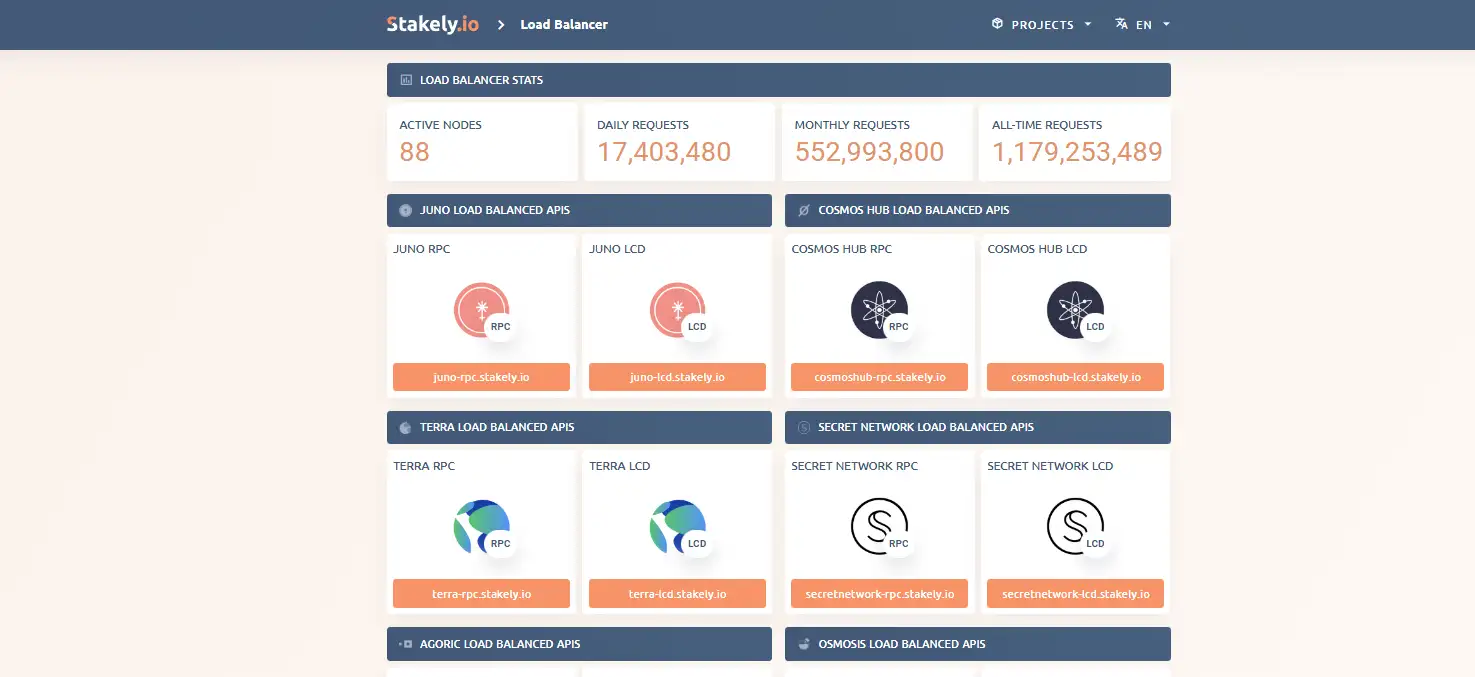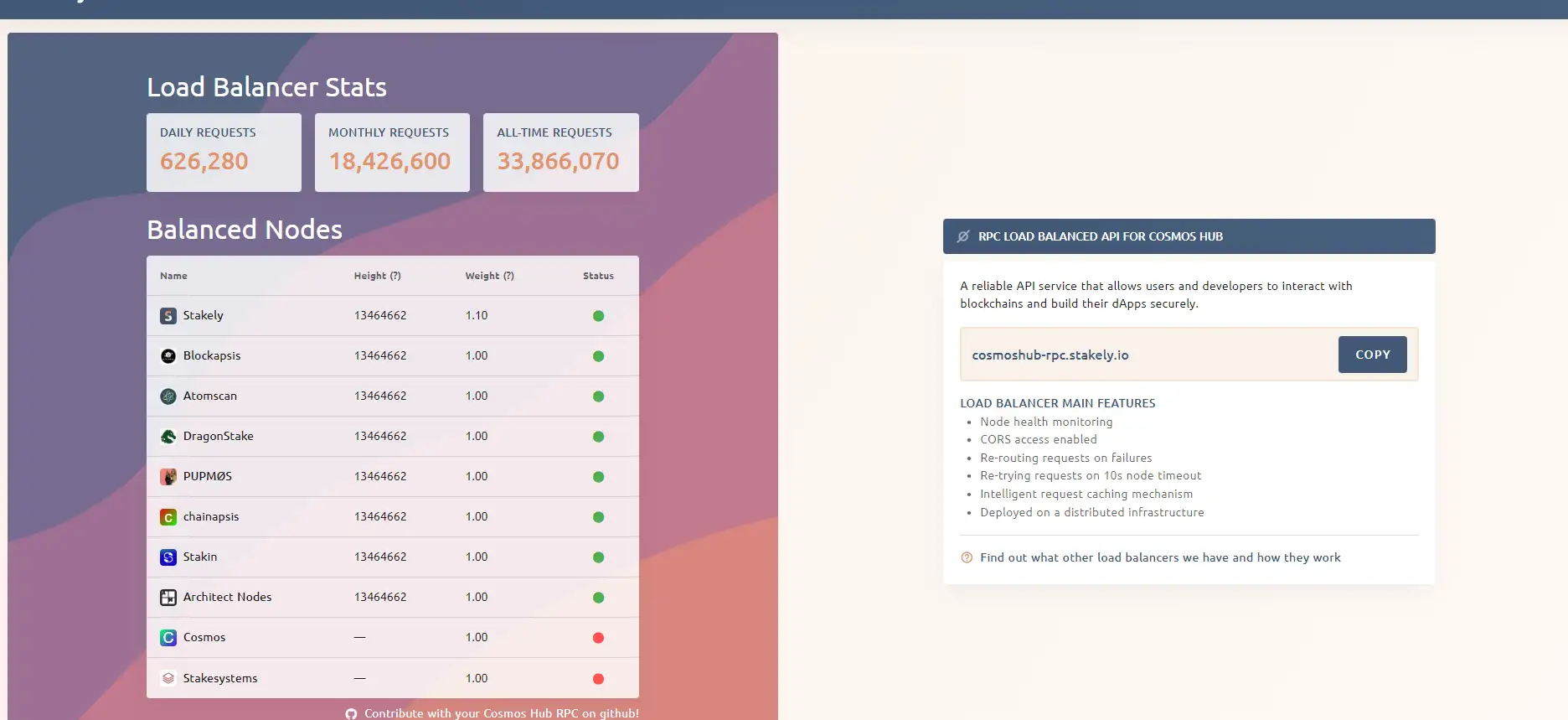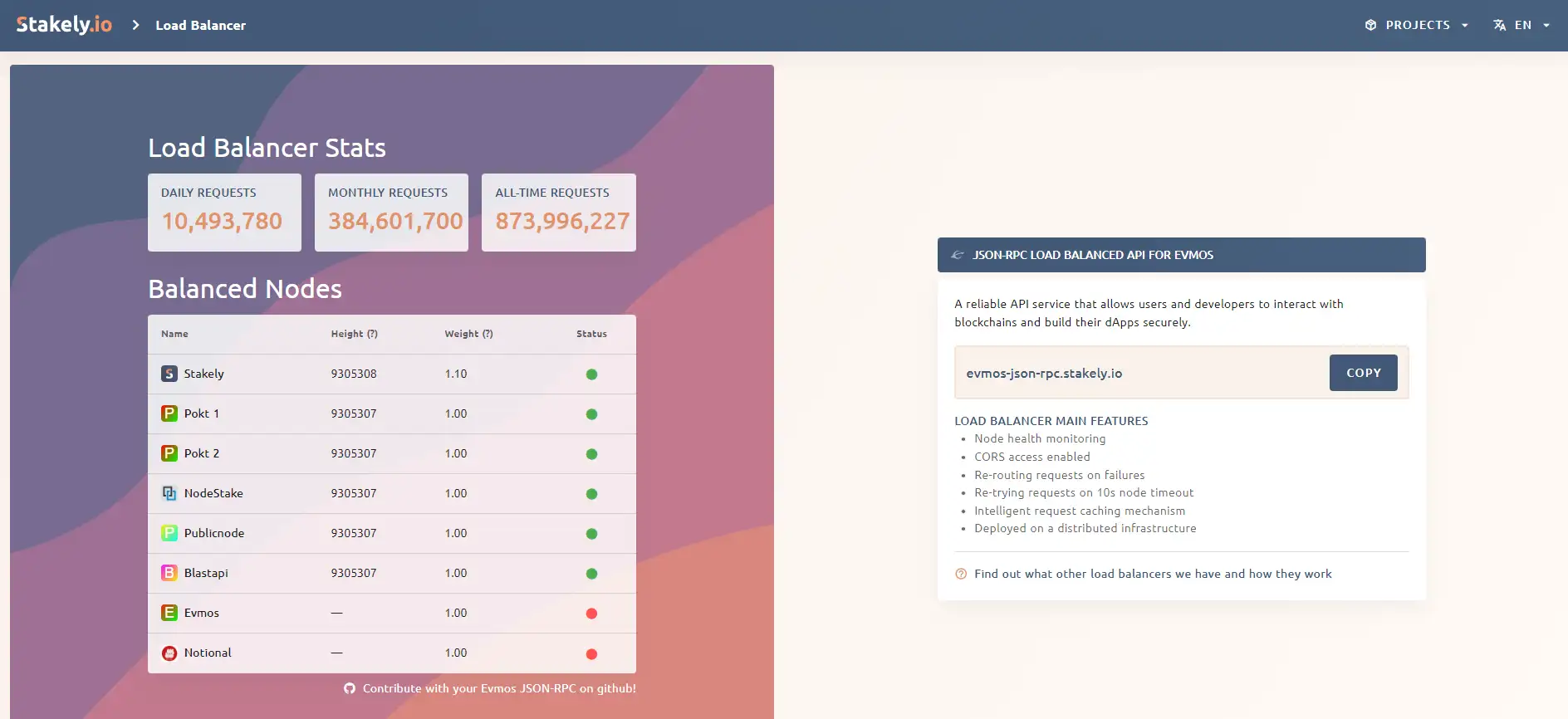About API Load Balancer
The Stakely Web3 API Load Balancer is an advanced tool designed to support the seamless operation of decentralized applications (dApps) by optimizing how data requests are managed and distributed across multiple blockchain nodes. In the rapidly evolving world of Web3, where decentralized networks are becoming increasingly congested due to the growing number of dApps, the need for efficient data handling has never been more critical. Stakely’s load balancer addresses this need by ensuring that API requests are evenly distributed across various nodes, thereby reducing the likelihood of bottlenecks and improving overall application performance.
The significance of this tool lies in its ability to enhance the reliability and speed of dApps, which are essential components of the decentralized ecosystem. As dApps handle an increasing number of users and transactions, they require robust backend support to maintain high performance and availability. Stakely’s Web3 API Load Balancer is engineered to provide this support by mitigating latency issues and ensuring that the infrastructure can scale effectively as demand grows. This solution is especially relevant for developers and enterprises looking to deploy or manage large-scale dApps that need to function efficiently in a highly decentralized and often unpredictable network environment.
The Stakely Web3 API Load Balancer is an integral part of Stakely's commitment to enhancing the decentralized ecosystem. This tool is designed to tackle the critical challenge of efficient data distribution in decentralized applications (dApps), ensuring reliable performance and minimizing network congestion. With the rapid growth of Web3 and the increasing adoption of blockchain technology, developers are facing new challenges related to scalability, performance, and infrastructure costs. The Stakely load balancer addresses these challenges by distributing API requests across multiple nodes, reducing latency, and improving the overall user experience.
The load balancer is compatible with a wide range of blockchains, including Ethereum, Cosmos, and Fantom, making it a versatile solution for developers working across different ecosystems. Over time, Stakely has continuously improved this tool, keeping pace with the evolving needs of the blockchain industry. The focus on cost efficiency and ease of integration makes the Stakely Web3 API Load Balancer an attractive option for projects of all sizes, from startups to large-scale enterprises.
When comparing Stakely’s solution to other industry offerings, such as Alchemy's Supernode and Infura, Stakely sets itself apart with its unique blend of affordability, extensive blockchain support, and user-friendly integration. These features make it a highly competitive choice for developers looking to enhance their dApps with reliable and scalable infrastructure. The tool has proven especially valuable for handling high-traffic environments and resource-intensive API requests, which are common in today’s decentralized applications.
- Reduced Infrastructure Costs: By optimizing resource use, the load balancer helps in cutting down operational expenses, which is crucial for startups and smaller projects operating on tight budgets.
- Increased Scalability: The load balancer enables dApps to handle more traffic and workloads, making it easier to scale operations as the user base grows without significant additional investments in infrastructure.
- Improved Performance: By distributing workloads across multiple nodes, the load balancer minimizes delays and ensures faster responses, which is critical for maintaining a positive user experience.
- Seamless Integration: The load balancer can be integrated with existing dApps simply by replacing the current endpoint URL with the Stakely load balancer URL, allowing for immediate performance enhancements without the need for complex modifications.
- Support for Multiple Blockchains: The tool supports various blockchains, including Ethereum, Cosmos, and Fantom, providing flexibility for developers working in different ecosystems.
- High Availability: The load balancer ensures that dApps remain accessible and operational even during peak traffic times, reducing the risk of downtime and ensuring consistent user experiences.
- Customizable Settings: Developers have the option to customize the load balancer settings according to their specific needs, allowing for greater control over how data is managed and distributed across the network.
- Ongoing Support and Updates: Stakely provides continuous updates and support for the load balancer, ensuring that it remains compatible with the latest blockchain technologies and can adapt to evolving user needs.
To get started with the Stakely Web3 API Load Balancer, follow these steps:
- Replace Endpoint URL: Identify the existing endpoint URL used by your dApp to connect to the blockchain network. Replace this URL with the Stakely load balancer endpoint URL provided during the registration process. This is a simple, yet crucial step that redirects your API requests through the load balancer, enabling optimized distribution across multiple nodes.
- No Additional Setup Required: Once the endpoint is updated, no further software installation or infrastructure setup is needed. This allows for an immediate improvement in your dApp’s performance, reducing latency and improving scalability.
- Access Documentation: Visit the Stakely website to access comprehensive documentation. This includes detailed guides on integration, best practices, and troubleshooting tips, ensuring a smooth setup process.
- Contact Support: If you encounter any issues or have specific customization needs, Stakely offers robust customer support. You can reach out to their team for assistance through their website, ensuring your dApp benefits fully from the load balancer’s capabilities.
By following these steps, developers can quickly and effectively integrate the Stakely Web3 API Load Balancer into their projects, benefiting from enhanced scalability, performance, and reliability.
API Load Balancer Reviews by Real Users
API Load Balancer FAQ
By distributing API requests across multiple blockchain nodes, the Stakely Web3 API Load Balancer reduces latency and prevents bottlenecks, ensuring faster response times and a smoother user experience for your decentralized application.
Yes, the Stakely Web3 API Load Balancer supports multiple blockchains including Ethereum, Cosmos, and Fantom, allowing developers to manage traffic efficiently across different networks from a single point.
The Stakely Web3 API Load Balancer optimizes resource use, reducing the need for extensive infrastructure investments and ongoing maintenance, which helps in lowering overall operational costs, especially for high-traffic dApps.
Integration is straightforward and fast. You only need to replace your current endpoint URL with the load balancer’s URL provided by Stakely, enabling immediate performance improvements without requiring any additional setup.
Absolutely, the Stakely Web3 API Load Balancer is designed to handle high-traffic environments by efficiently distributing requests and preventing overload on any single node, ensuring your dApp remains responsive even during peak usage times.
You Might Also Like












